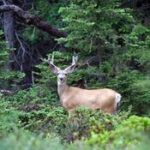If your shrubs are looking sickly, you may have a problem with garden pests. Common garden pests include voles, deer and insects. If your first thought is to reach for store-bought pest control sprays, you may want to reconsider. These often include toxic chemicals than can be harmful to children and family pets. Some may also contaminate the soil and water supply. Natural pest control methods are a safer alternative
The first step in natural pest control is identifying the pest. Otherwise, you’re left trying different methods until you hit on one that works. By taking the time to identify the pest before you start treating, you’ll save yourself time, money and aggravation.
Voles
Voles are discreet pests. You may never see them as they’re burrowing their way through your yard, but you will definitely see the results of their work. The burrowing can weaken the root system of your plants, causing them to lean. They sometimes eat the base of the shrub as well. Natural pest control for voles may involve extermination, trapping, protecting, repelling, or a combination of methods. I generally recommend against extermination because the poison can be toxic to children and pets.
Traps are a humane method of dealing with voles. However, keep in mind that if you trap the vole, you then have to find a new place for it. In some states, this can be a problem due to legislation against animal relocation.
Protection is a partial approach to pest control, but it has drawbacks. To protect shrubs, simply wrap a piece of wire mesh around the base of the shrub. This will block the vole from chewing. However, this doesn’t keep them from burrowing under the plant, wreaking havoc on the root system.
Repelling can be very effective against voles. This can be accomplished by purchasing the urine of vole predators, such as fox or coyote, and sprinkling the urine around the shrub. When the vole smells the urine, they believe a predator is nearby and flee.
Deer
If the neighborhood deer are to blame for your shrub problems, the simplest solution is to block and/or deter them. Deer fences are designed to keep deer from getting near your plants. A deer fence is basically just a fence built high enough deer can’t jump over it. Variations of the deer fence include an electrified fence and one that is nearly invisible.
There are some plants that can provide natural pest control when deer is the pest. Deer find these plants repellent due to the smell. These include Allegheny spurge, catnip, deadnettle, blue oat grass, bugleweed and creeping thyme.
Insects
If insects are to blame, organic garden pesticides can provide safe natural pest control. Organic pesticides include Neem oil, insecticidal soap, and rotenone. Neem oil comes from the seeds of neem tree fruit. To use, simply spray on the leaves of your shrub. It works by interfering with the hormonal system of insects, which keeps them from maturing. While it is non-toxic for humans, you should use care if you have pets. Keep them away from the plant until the leaves have dried. Neem oil is not a fast-acting method, but it is effective given enough time. Keep in mind that it will need to be reapplied after rain and sunlight breaks it down as well.
Insecticidal soap works by collapsing the insects’ cells. It is one of the safest organic pesticides for humans and pets. One thing to remember is that it no longer works once it dries so you need to be sure to cover all insects if possible. Read the label before using on plants as some plants are sensitive to insecticidal soaps.
Rotenone comes from tropical legume roots. It works by blocking oxygen in insects’ tissue cells. To use, simply dust it on the plant. Keep in mind that sunlight breaks it down quickly and it can be harmful to bees so it’s best to use it in the evening.
Source:
http://landscaping.about.com/od/pestcontrol/Control_of_Garden_Pests_lnsect_and_Rodent_Garden_Pests.htm


